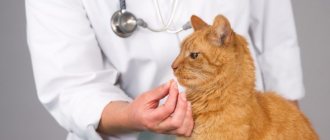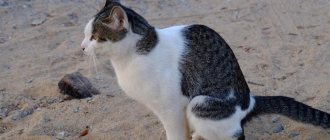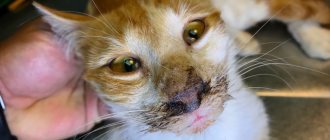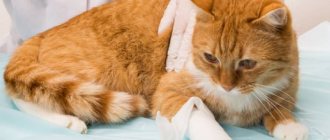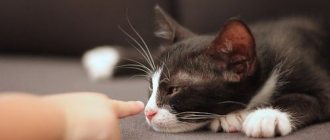What will you learn from the article?
- Types of stomatitis Classification by location
- Classification according to the nature of inflammation
- Classification by origin
- Classification according to the course of the disease
- 10 signs of stomatitis
- What causes primary stomatitis
- How to help your cat before visiting a doctor
Stomatitis in cats is a painful inflammatory disease of the soft tissues of the oral cavity. The danger of this pathology is that if not treated promptly, it can cause serious complications. Inflammatory processes are manifested by redness of the mucous membranes and the appearance of ulcers. Foci of localization of the disease: tongue, corners of the mouth, gums, lips, lingual-palatal folds. In advanced cases, the entire oral cavity of the animal is affected.
Is it possible to prevent stomatitis in cats, what are the symptoms of the pathology, how to help a sick pet, what treatment methods are best - you will find the answers to all these questions in our article.
What is stomatitis
Stomatitis in a cat is an inflammatory disease of the oral mucosa (usually the corners of the mouth, lips, tongue, gums, lingual palatine folds) with possible complications in the absence of proper treatment. It is contagious to animals, so a sick cat should be protected from contact with other pets.
According to localization, the types of the disease can be classified as follows:
- gingivitis - inflammation affects the gums of the animal;
- gingivostomatitis - inflammation covers the mucous membrane of the entire mouth and gums;
- glossitis - affects the tongue;
- palatinitis - affects the palate;
- faucitis - in this case, the palatoglossal folds are subject to inflammation;
- cheilitis - inflammation affects the lips.
According to the duration of the disease, the disease can be acute - up to 2 weeks, subacute - 2-6 weeks, and chronic - more than 6 weeks, in which the animal generally feels unwell.
Treatment options
How can stomatitis in cats be treated? There are several treatment options that can completely eliminate the infection. In addition, special medications stop the development of the inflammatory process.
It is worth noting! First of all, you should carefully examine your pet; to do this, you need to take him to an appointment with a veterinarian. The doctor performs a visual examination and asks the owner about the presence of suspicious symptoms. Laboratory tests are required.
Feline stomatitis is treated in several ways:
- Surgery is usually used in cases where the cat has extensive lesions. During it, areas of the mucous membrane that have undergone severe changes are removed. If they are not removed in a timely manner, they will cause serious complications, including complete death of the mucosal tissue. This method is used to treat gangrenous stomatitis. Surgical intervention is performed in the presence of autoimmune processes in which teeth are removed. No more than two teeth are removed at a time;
- Combined treatment method. During it, surgical cleaning of the oral cavity, tooth extraction and further drug therapy are carried out;
- Drug therapy. This type of treatment can be used at home, but under the supervision of a specialist. It is aimed at cleansing the animal’s oral cavity from infection, pus, and tissue decay. It also speeds up the healing process and restores the affected mucous layer.
Main signs of the disease
You can assume that a cat has stomatitis based on the following signs:
- loss of appetite;
- constant thirst appears;
- the cat often rubs its muzzle with its paw or rubs its muzzle against objects/the floor in an attempt to relieve pain;
- temperature rises;
- lack of washing and hygiene due to pain in the mouth;
- increased salivation;
- constantly wet fur around the mouth;
- apathy and drowsiness;
- pinkish saliva - due to bleeding wounds - or viscous and yellowish - due to an admixture of pus;
- swollen lymph nodes in the jaw and neck.
“Murkoshi” volunteers carefully care for each animal and recommend that cat owners not delay visiting the veterinarian if symptoms of illness are detected.
Which cats are at risk?
Stomatitis can be primary (self-developing) or secondary, occurring as a parallel symptom of another disease.
Causes of primary stomatitis:
- mechanical injuries (scratches, punctures, wounds) due to a defective bite or a sharp object caught in the mouth;
- chemical/thermal exposure, including excessively hot or icy food, burns from household chemicals and poisonous plants.
Causes of secondary stomatitis:
- allergic reaction to food;
- bacterial, viral and fungal infections (panleukopenia, candidiasis, leukemia and others);
- endocrine diseases, such as diabetes;
- diseases of the liver, kidneys and gastrointestinal tract (hepatitis, gastroenteritis and others);
- dental pathologies (autoimmune reactions, caries or tartar deposits).
Important! Cats at risk for stomatitis include cats with a weakened immune system (sick, lactating and elderly), with an incorrectly formed bite, and those who have microtraumas/burns in the oral cavity.
The oral cavity is the Achilles heel of British Shorthair cats, in which stomatitis is diagnosed more often than in other breeds. Young animals that exhibit “juvenile” stomatitis are also susceptible to it during the period of teeth change.
Return to content
Causes of stomatitis
Stomatitis in a cat occurs due to any injury or disease. Depending on the causes of the disease, primary and secondary stomatitis are distinguished.
Primary develops when:
— thermal burn (too hot food or inhalation of steam);
— chemical burn (swallowed alkaline solutions, salts of heavy metals, etc.);
- mechanical trauma to the mouth (bad bite, damage to the gums or cheeks from small bones while eating).
Secondary stomatitis in kittens and cats develops against the background of stress, weak immunity or as a result of diseases:
- diabetes mellitus and other difficulties with the endocrine system;
- lack of vitamins (as a rule, stomatitis can be caused by a lack of A, B, C, E and PP);
— infectious (calcivirosis, rhinotracheitis, papillomatosis, etc.);
— renal failure and diseases of the gastrointestinal tract (colitis, gastritis, etc.);
- allergies to medications, food or, conversely, inedible products (plants, shampoo, paint from toys, etc.);
— problems with gums and teeth (periodontitis, periodontal disease, caries, etc.);
— oncology, especially in the neck and head;
- autoimmune diseases.
Stomatitis can also be caused by poor oral hygiene or feeding from dirty dishes. It is necessary to introduce specialized food into the cat’s diet that prevents the deposition of tartar, or to remove it in a timely manner at a veterinary clinic.
Read more: Removing tartar from a cat
Diagnostics
Diagnosis should only be carried out in a veterinary clinic. This is due to the fact that the disease has many subforms and causes that cause it.
In addition, the pathology is very painful, so in some cases, examination and treatment procedures are only possible under local or general anesthesia. In some cases, it may be necessary to hospitalize the animal, remove teeth, or perform surgical operations.
The set of diagnostic measures includes:
- Anamnesis collection. Possible causes of the pathology are identified.
- Visual examination of the oral cavity. The nature and extent of the damage is determined.
- Rinse from the oral mucosa followed by culture of secretions.
- Blood chemistry.
- Analysis of urine.
- Test for viral infection.
Based on the diagnostic results, a decision is made on treatment methods and the need for inpatient care.
Treatment of stomatitis in adult cats
As Henry Bates said, “Cats are happy creatures. They don’t care about anything at all!” And this is true - until the cat gets sick. Furry pets are not always able to help themselves on their own, and then they need the care of their owner. Well, his duty is to follow the veterinarian’s recommendations.
Depending on the type of stomatitis in a cat, its severity and the general condition of the animal, the doctor may prescribe medication - including drugs and immunomodulatory drugs, surgery - when removal of the affected mucous membrane, tartar or teeth is required, or combination therapy - consisting of surgical intervention followed by prescription of medications.
Widely used drugs for the treatment of stomatitis in cats:
- Antiviral, antimicrobial, antibiotic and antifungal
— “Amoxicillin” 15%. 1 time subcutaneously or intramuscularly, dosage 1ml/10kg (or 15ml/kg).
- "Oxytetracycline." A course of 3-5 days, 1 ruble/day at a dosage of 0.1 ml/kg.
— “Lincomycin” 10%. Dosage intramuscularly – 2ml/10kg, intravenously – 1ml/10kg. Course 3-7 days.
- Oxolinic or Nystatin ointments, "Cholisal". Apply locally, a thin layer to inflamed areas.
- Antiseptics
— “Chlorhexidine” (0.05%). Rinse mouth or treat wounds topically.
- "Dentavedin-gel." 2-3 times a day, apply a thin layer to sore gums or into the sockets of extracted teeth.
— “Lugol” with glycerin, including spray, “Metrogil-denta”, “Protargol” (1.5%). Spray or smear on ulcers.
- Restorative and wound-healing drugs
- “Actovegin-gel”, “Levomekol”, rosehip and sea buckthorn oils. Apply a thin layer to ulcers and wounds when the inflammation has passed.
- Drugs to enhance immunity
- "Kathozal". 0.5-2.5 ml/cat, once. If necessary, repeat after 3-5 days.
- “Gamavit.” 0.3-0.5 ml/kg 1-3 times every 7 days. Course from 2 to 4 weeks.
- “Hemobalance. 0.25 ml/cat weighing up to 5 kg and 0.5 ml/cat over 5 kg, 2-3 times a week.
- For stomatitis that has developed against the background of autoimmune diseases, the following drugs may be prescribed:
- Cyclosporine. 7 mg/kg 1 time per day. The course is from 4 to 16 weeks (depending on the severity of the disease).
- “Prednisolone.” To suppress inflammation – 0.5 mg/kg 2 times a day. For complete treatment – 1-3 mg/kg twice a day.
- Painkillers and disinfectant sprays
— “API-SAN”, “Candioli”, “Zubastic”, “Oral-Relax”.
- Vitamins
Features of the pathology
Stomatitis in cats is a disease caused by viruses, which gives the pet unpleasant pain in the mouth. In severe cases of the disease, there is a risk that the animal may lose one or more teeth. Therefore, it is important to identify stomatitis in the early stages and provide your pet with qualified veterinary care and proper care. It is worth noting that this disease can progress to more serious stages, thereby provoking the development of leukemia. This is especially true for cats with reduced immunity.
In the initial stages, the animal's gums are affected, becoming bright red and, in some cases, bluish in color. Over time, they begin to bleed and severe pain appears when chewing, and damage to the mucous membrane spreads throughout the animal’s mouth. In the absence of qualified help and immunity support, stomatitis can be fatal.
An attentive owner is obliged to notice the first signs of the disease as early as possible. If ulcerative stomatitis in cats is detected in the early stages, treatment will be quick and simple.
The first signs of stomatitis in a cat:
- The amount of saliva produced increases;
- Thirst increases;
- Appetite disappears, the process of chewing food becomes longer and more difficult;
- Bad breath appears, which indicates increased microbial activity;
- The mood and desire to play disappear;
- The animal sleeps for a long time and becomes very apathetic;
- Increased body temperature;
- Enlargement of lymph nodes in the neck;
- The mucous membranes of the mouth swell and acquire a red tint, and also acquire a white-gray coating.
If there are several symptoms of the disease, it is necessary to take the animal to the veterinarian as soon as possible.
Stomatitis in kittens
Children are even more susceptible to this disease than adult animals. This is due to changing teeth and weak immunity. The development of stomatitis in a kitten can also be caused by improper or lack of oral hygiene, poor nutrition, lack of calcium, and various stresses.
It is necessary to monitor the appearance of plaque when changing teeth, the appearance of wounds in the mouth, closely monitor the pet’s well-being, diversify the diet by including vitamins and essential minerals, and periodically examine the baby.
Stomatitis in kittens, as a rule, can be easily cured with the help of solutions, antibiotics, and hygiene.
What to do at home
The owner must strictly follow the veterinarian's instructions. It is prohibited to prescribe medications yourself, increase or decrease their dosage! Some pet owners prefer not to go to a veterinary clinic and treat their pets with folk remedies.
It is not forbidden to use decoctions of medicinal herbs (sage, chamomile, oak bark, etc.), but they should be used as an addition to traditional treatment.
A disease as serious as stomatitis requires adjustments in diet. The diet should be enriched with nutrients and consist of liquid and semi-liquid foods. Chicken and beef broths, pureed soups, and pureed porridges are ideal.
It should be taken into account that a weakened cat, experiencing pain and discomfort when eating, will refuse to eat.
In this case, you should force feed, introducing food into your mouth using a syringe. You need to act carefully so that the animal does not choke.
Odontoclastic resorptive lesions of teeth in cats.
Cat, 5 years old. Odontoclastic resorptive lesion of the cervical region of the lower premolar.
A very common dental disease characteristic of the cat family. This is a non-carious lesion of the teeth, characterized by the appearance of cavities on the crown or root of the tooth. Most often, the lesion occurs in the cervical region. The cavity may be covered by an overgrowth of granulation tissue, and therefore is not immediately noticed by the owners.
Clinically, the disease manifests itself as follows: the cat does not lose interest in food, but it eats with caution, and the cat may suddenly drop food, and sometimes there is trembling of the lower jaw when eating food. You can observe bleeding gums, swelling and redness around the affected tooth, dental deposits on the affected tooth, part of the tooth may be covered by gum or, more often, granulation tissue.
The etiology of the disease is unknown; there are many theories, but none of them have been proven.
There are types 1 and 2 of the disease. Type 1 – non-carious tooth decay in cats, which does not lead to the replacement of destroyed roots with bone tissue. The radiography clearly shows the roots and periodontal space. Type 2 – non-carious tooth decay in cats, leading to the replacement of damaged roots with bone tissue. On radiography there are no clear boundaries of the root, the periodontal fissure is not visualized.
There are five stages of Odontoclastic resorptive damage to teeth in cats.
The first stage of damage is a cement defect. Odontoclasts destroy enamel and dentin, forming a resorptive tooth cavity.
The second stage is characterized by damage to cementum or enamel and dentin (the main tissue of the tooth). The third stage is deeper damage to the hard tissue of the tooth. The formation of mineralized plaque is often found on the surface of such teeth.
The fourth stage - the pulp chamber is exposed, high sensitivity and pain in the teeth appears. Subsequently, the crown of the tooth breaks, and the roots remain in the alveolus - this is the last fifth stage of the disease.
To make a diagnosis, a thorough examination of the cat’s oral cavity and x-rays are sufficient. X-ray diagnostics makes it possible to detect root resorption, which cannot be seen visually during examination. Therefore, if (FORL) is suspected, a complete x-ray examination of the oral cavity is recommended, which involves 6 to 10 intraoral photographs of the teeth.
The only treatment for stage 2-5 teeth is complete extraction of such teeth (extraction). After this, curettage of the hole is performed, followed by suturing of the gum mucosa.
Preventive measures
It is, of course, impossible to completely exclude the occurrence of stomatitis, but it is necessary to minimize the factors that provoke its occurrence and development.
The owner will need:
- avoid the presence of sharp bones in food;
- monitor the temperature of the cat food (it should be slightly above room temperature);
- do not pour cold water into the drinking bowl;
- remove household/garden chemicals from the cat;
- get rid of poisonous indoor plants.
To maintain general immunity, you will need to take your cat for routine vaccination.
Return to content
When visiting a doctor is unavoidable
What to do if it is not possible to cure a cat at home, if the pet’s condition worsens day by day (appetite disappears completely, in addition to ulcers in the mouth, pus forms)? Home treatment should be stopped and contact a specialist immediately. There is a possibility that the doctor will recommend the use of antibiotics (Amoxicillin, Oxytetracycline and other drugs that should only be prescribed by a specialist), immunomodulators (Gamavit, Hemobalance), and vitamins.
It is also important to identify the cause of the disease. So, for example, treatment of ulcerative stomatitis caused by, say, rhinotracheitis, will include taking antihistamines. And if inflammation of the oral mucosa is a consequence of liver problems, the animal will probably need to take hepatoprotectors and painkillers. In other words, it is better to entrust the selection of medications for the treatment of stomatitis to a veterinarian.
Start
The initial stage of development of stomatitis is considered to be the catarrhal stage . It manifests itself in the form of inflammation of the oral cavity and the appearance of shallow ulcers. If you start treating catarrhal stomatitis in time, the infection process will not go further.
A more advanced version of the catarrhal stage is acute ulcerative stomatitis . The symptoms of this stage are immediately noticeable - the animal’s tongue and gums become covered with festering ulcers and granulations, causing a lot of trouble. The cat will have difficulty swallowing, salvation (excessive salivation) will continue, and he will breathe with foam at his open mouth.
Eating with such wounds is impossible, but the cat will be very thirsty, since the mucous membranes will become very dry. This is made worse by the fact that the cat will temporarily lose its ability to wash itself. The animal's breath will begin to smell unpleasant (“as if someone had died there”) and the temperature will rise.
Granulations (white small ulcers in large numbers) may indicate such serious diseases as feline distemper, acute infections and damage to the pharynx. Antibiotics are required to treat them.

